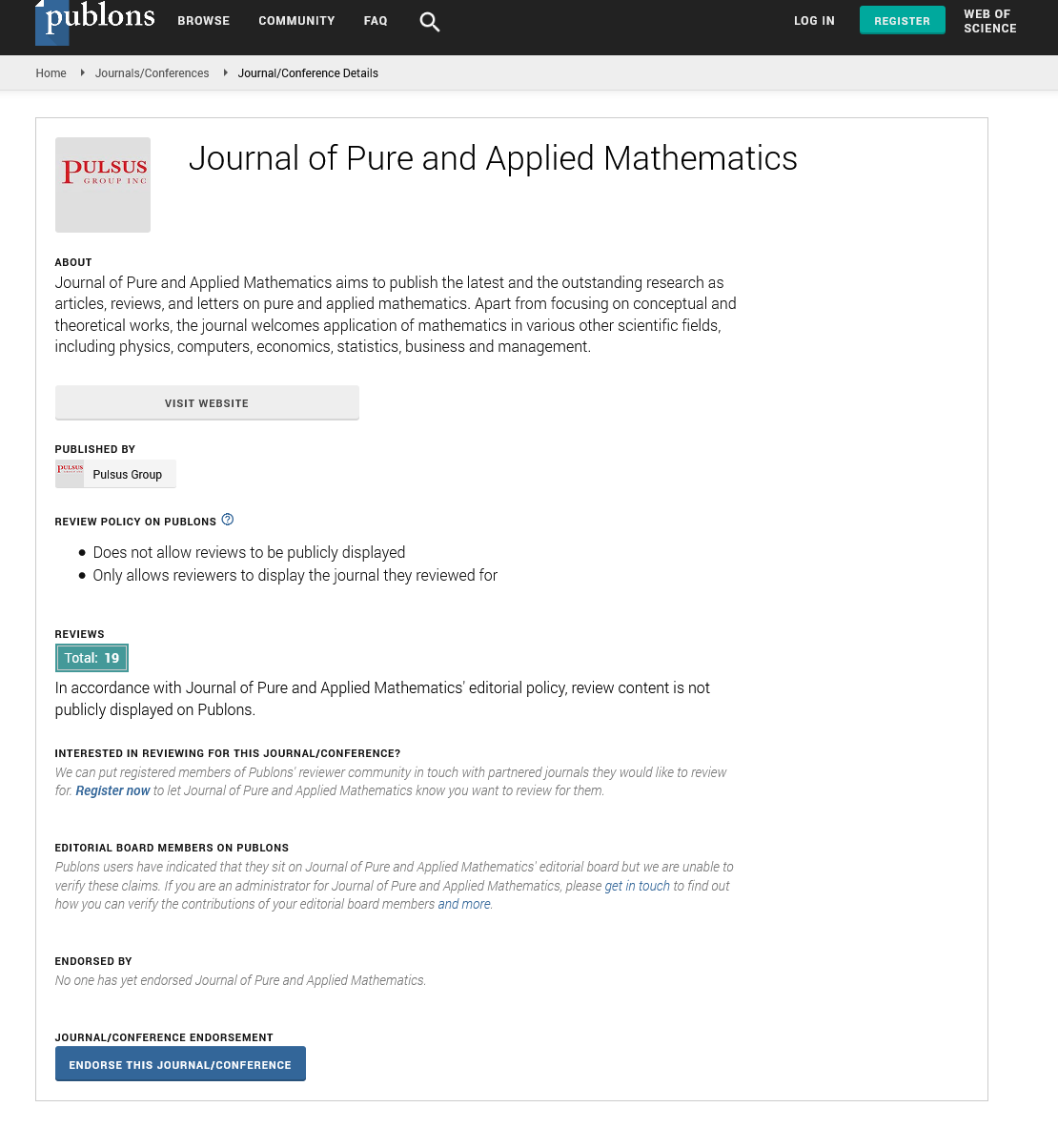Prime number-large number factorization 2
Received: 30-Oct-2023, Manuscript No. PULJPAM-23-6840; Editor assigned: 01-Nov-2023, Pre QC No. PULJPAM-23-6840 (PQ); Reviewed: 15-Nov-2023 QC No. PULJPAM-23-6840; Revised: 07-Jan-2025, Manuscript No. PULJPAM-23-6840 (R); Published: 14-Jan-2025
Citation: Hong S. Prime number-large number factorization 2. J Pure Appl Math. 2025;9(1):1.
This open-access article is distributed under the terms of the Creative Commons Attribution Non-Commercial License (CC BY-NC) (http://creativecommons.org/licenses/by-nc/4.0/), which permits reuse, distribution and reproduction of the article, provided that the original work is properly cited and the reuse is restricted to noncommercial purposes. For commercial reuse, contact reprints@pulsus.com
Description
The contents of an existing document have invalid entries. First upload the proof, and a week later upload a Java source that handles 53 large numbers of factorizations. The content is not difficult to write. I will write it so that anyone can easily solve it.
The positive integer is successively put into 9 buckets and the number of buckets adds the large number until it becomes one place and one place becomes the corresponding bucket (Tables 1 and 2).
| 1Bucket | 2Bucket | 3Bucket | 4Bucket | 5Bucket | 6Bucket | 7Bucket | 8Bucket | 9Bucket |
|---|---|---|---|---|---|---|---|---|
| 1 | 2 | 3 | 4 | 5 | 6 | 7 | 8 | 9 |
| 10 | 11 | 12 | 13 | 14 | 15 | 16 | 17 | 18 |
| 19 | 20 | 21 | 22 | 23 | 24 | 25 | 26 | 27 |
| 28 | 29 | 30 | 31 | 32 | 33 | 34 | 35 | 36 |
| : | : | : | : | : | : | : | : | : |
| 100 | 101 | 102 | 103 | 104 | 105 | 106 | 107 | 108 |
| : | : | : | : | : | : | : | : | : |
Table 1: Bucket configuration
| 1Bucket | 2Bucket | 4Bucket | 5Bucket | 7Bucket | 8Bucket |
| 1Bucket* 1Bucket | 1Bucket* 2Bucket | 1Bucket* 4Bucket | 1Bucket* 5Bucket | 1Bucket* 7Bucket | 1Bucket* 8Bucket |
| 2Bucket* 5Bucket | 2Bucket* 1Bucket | 4Bucket* 1Bucket | 5Bucket* 1Bucket | 7Bucket* 1Bucket | 8Bucket* 1Bucket |
| 5Bucket* 2Bucket | 4Bucket* 5Bucket | 2Bucket* 2Bucket | 2Bucket* 7Bucket | 2Bucket* 8Bucket | 2Bucket* 4Bucket |
| 4Bucket* 7Bucket | 5Bucket* 4Bucket | 7Bucket* 7Bucket | 7Bucket* 2Bucket | 8Bucket* 2Bucket | 4Bucket* 2Bucket |
| 7Bucket* 4Bucket | 7Bucket* 8Bucket | 5Bucket* 8Bucket | 4Bucket* 8Bucket | 4Bucket* 4Bucket | 5Bucket* 7Bucket |
| 8Bucket* 8Bucket | 8Bucket* 7Bucket | 8Bucket* 5Bucket | 8Bucket* 4Bucket | 5Bucket* 5Bucket | 7Bucket* 5Bucket |
Table 2: Example bucket configuration
9 buckets are multiples of 9, 3 buckets and 6 buckets are multiples of 3, so 1, 6 and 9 buckets are multiples of 3, so they can be divided by 3.
The number 33,385,279 is not so large. In large numbers, the factorization value is unknown, but the number 33,385,279 is the multiplication of two numbers 3571 and 9349.
The number 33,385,279 is included in 4 bucket. The multiplication 4 bucket of two numbers is one among the two numbers is 1 bucket* 4 bucket, 4 bucket* 1 bucket, 2 bucket* 2 bucket, 7 bucket* 7 bucket, 5 bucket* 8 bucket and 8 bucket* 5 bucket. 3571 is a 7-bucket and 9349 is a 7-bucket.
33,385,279-3570* 9340=41,479=> 4 buckets-6 buckets* 9+4 buckets because it should not be negative in 7 buckets==> 13-6=7 (41,479 is 7 buckets) 33,385,279-3500* 9300=835,279=> 4 buckets-8 buckets* 9+4 buckets because it should not be negative in 3 buckets==> 13-6=7 (835,279 is 7 buckets).
A large number of factorizations do not know the two numbers. x Bucket* y Bucket= 33,385,279 x Bucket, y Bucket is one of 1 bucket* 4 bucket, 4 bucket* 1 bucket, 2 bucket* 2 bucket, 7 bucket* 7 bucket, 5 bucket* 8 bucket and 8 bucket* 5 bucket.
(x bucket-1) (y bucket-9)=x bucket*y bucket-y bucket-9*x bucket +9=33,343,800[6 bucket] only 7 buckets* 7 buckets are processed.






